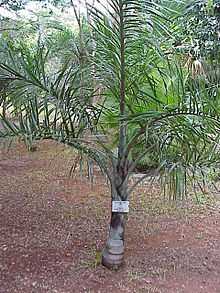Pseudophoenix
From Wikipedia, the free encyclopedia
| Pseudophoenix | |
|---|---|
 | |
| Pseudophoenix sargentii | |
| Scientific classification | |
| Kingdom: | Plantae |
| (unranked): | Angiosperms |
| (unranked): | Monocots |
| (unranked): | Commelinids |
| Order: | Arecales |
| Family: | Arecaceae |
| Subfamily: | Ceroxyloideae |
| Tribe: | Cyclospatheae |
| Genus: | Pseudophoenix H.Wendl. ex Sarg. |
| Species | |
|
Pseudophoenix ekmanii | |
Pseudophoenix is a genus of palms which is native to the wider Caribbean. Three species of the four species are endemic to the Greater Antilles, while the fourth, P. sargentii, is widely distributed in the northern Caribbean and adjacent portions of the Central and North American mainland.
Trees in this genus are medium to large palms with single, unclustered trunks. They lack spines and have pinnately compound leaves. Flowers are green and bisexual, while the ripe fruit are red.[1]
References
- ↑ Acevedo-Rodríguez, Pedro; Mark T. Strong (2005). "Monocots and Gymnosperms of Puerto Rico and the Virgin Islands". Contributions of the United States National Herbarium 52: 1–405.
- "Pseudophoenix H.Wendl. ex Sarg., Bot. Gaz. 11: 314 (1886)". Royal Botanic Gardens, Kew: World Checklist of Selected Plant Families. Retrieved 2007-01-16.
This article is issued from Wikipedia. The text is available under the Creative Commons Attribution/Share Alike; additional terms may apply for the media files.